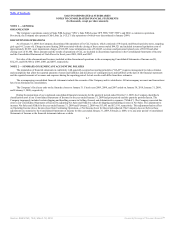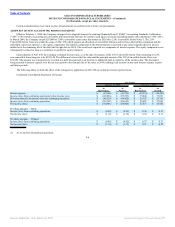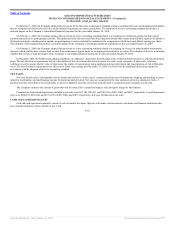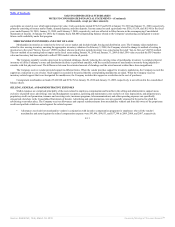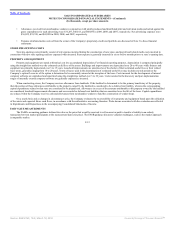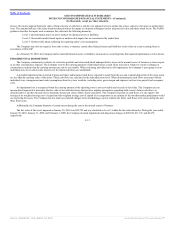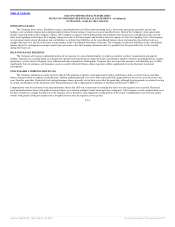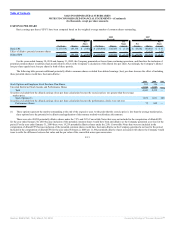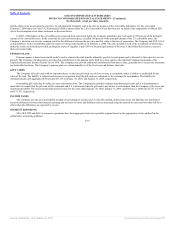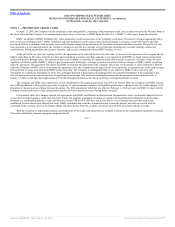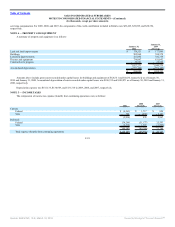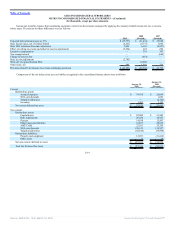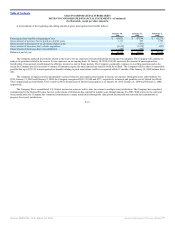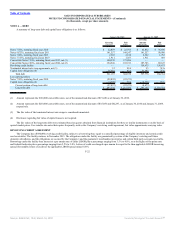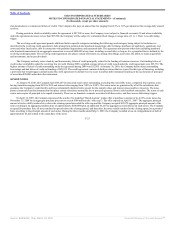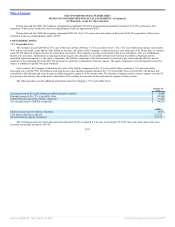Saks Fifth Avenue 2009 Annual Report Download - page 73
Download and view the complete annual report
Please find page 73 of the 2009 Saks Fifth Avenue annual report below. You can navigate through the pages in the report by either clicking on the pages listed below, or by using the keyword search tool below to find specific information within the annual report.
Table of Contents
SAKS INCORPORATED & SUBSIDIARIES
NOTES TO CONSOLIDATED FINANCIAL STATEMENTS—(Continued)
(In thousands, except per share amounts)
NOTE 3 — PROPRIETARY CREDIT CARDS
On April 15, 2003, the Company sold its proprietary credit card portfolio, consisting of the proprietary credit card accounts owned by the National Bank of
the Great Lakes and the Company’s ownership interest in the assets of the trust, to HSBC Bank Nevada, N.A. (“HSBC”), a third party financial institution.
HSBC, an affiliate of HSBC Holdings PLC, offers proprietary credit card accounts to the Company’s customers. Pursuant to a program agreement with a
term of ten years expiring in 2013, HSBC establishes and owns proprietary credit card accounts for the Company’s customers, retains the benefits and risks
associated with the ownership of the accounts, receives the finance charge income and incurs the bad debts associated with those accounts. During the ten-year
term, pursuant to a servicing agreement, the Company continues to provide key customer service functions, including new account openings, transaction
authorizations, billing adjustments and customer inquiries, and receives compensation from HSBC for these services.
At the end of the ten-year term expiring in 2013, the agreement can be renewed for two two-year terms. At the end of the agreement, the Company has the
right to repurchase, at fair value, all of the accounts and outstanding accounts receivable, negotiate a new agreement with HSBC or begin issuing private label
credit cards itself or through others. The agreement allows the Company to terminate the agreement early following the occurrence of certain events, the most
significant of which would be HSBC’s failure to pay owed amounts, bankruptcy, a change in control or a material adverse change in HSBC’s ability to perform
under the agreement. The agreement also allows for HSBC to terminate the agreement if the Company fails to pay owed amounts or enters bankruptcy. Should
either the Company or HSBC choose to terminate the agreement early, the Company has the right, but not the requirement, to repurchase the credit card accounts
and associated accounts receivable from HSBC at their fair value. The Company is contingently liable to pay monies to HSBC in the event of an early
termination or a significant disposition of stores. The contingent payment is based upon a declining portion of an amount established at the beginning of the
ten-year agreement and on a prorated portion of significant store closings. The maximum contingent payment had the agreement been terminated early at
January 31, 2010 would have been approximately $16,340. Management believes the risk of incurring a contingent payment is remote.
The Company and HSBC have entered into several amendments to the program agreement since 2003. In October 2009, the Company and HSBC entered
into a fifth amendment to the program agreement in response to macroeconomic conditions and portfolio performance, which provides for certain changes to the
allocation of risk and revenue sharing between the parties. The fifth amendment, which became effective February 1, 2010, provides for HSBC to share with the
Company certain credit losses of the card portfolio and also provides increased revenue sharing to the Company.
In September 2006, the Company entered into agreements with HSBC and MasterCard International Incorporated to issue a co-branded MasterCard card
to new and existing proprietary credit card customers. Under this program, qualifying customers are issued a SFA and MasterCard branded credit card that
functions as a traditional proprietary credit card when used at any SFA or OFF 5TH store and at Saks Direct or as a MasterCard card when used at any
unaffiliated location that accepts MasterCard cards. HSBC establishes and owns the co-brand accounts, retains the benefits and sales associated with the
ownership of the accounts, receives the finance charge and other income from the accounts, and incurs the bad-debts associated with the accounts.
With the exception of depreciation expense, all components of the credit card operations are included in SG&A in the Consolidated Statements of Income.
The credit contribution comprises program compensation and
F-17
Source: SAKS INC, 10-K, March 18, 2010 Powered by Morningstar® Document Research℠


